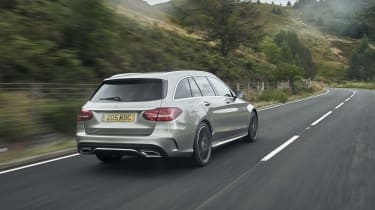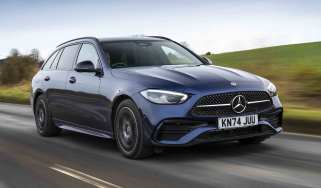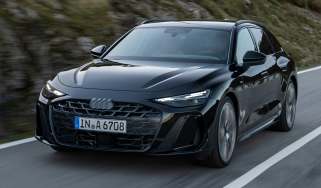Mercedes C-Class Estate review (2014-2021)
"The Mercedes C-Class Estate is a stylish, comfortable and practical family car"
Pros
- Big boot and practical interior
- Comfortable suspension
- Luxurious cabin
Cons
- Diesel engines can be noisy
- Air suspension bumpy at low speeds
- BMW 3 Series Touring is better to drive
The Mercedes C-Class Estate enters a class that already contains upmarket estate cars such as the Audi A4 Avant and the brilliant BMW 3 Series Touring. It’s good looking – arguably more so than its two main rivals – with a swish exterior and has the usual Mercedes qualities of excellent build quality and a luxurious cabin.
In 2018, the C-Class Estate received the same upgrades as the C-Class saloon, Coupe and Cabriolet. Perhaps most importantly, a range of more fuel-efficient engines was introduced. Among these is a 1.5-litre petrol – the smallest yet fitted to a C-Class – that uses clever EQ Boost mild-hybrid technology. It can recover energy that would otherwise be lost under braking and then gives the combustion engine a 14bhp helping hand under acceleration, improving efficiency. It also allows the engine to temporarily turn off while coasting and stopping in traffic, adding up the fuel savings.
The 2.0-litre diesel engine fitted in the C 220 d was also new for 2018, and is smoother and quieter than the previous 2.1-litre, while offering improved fuel economy. It still can't match the smoothness of the petrols, though.
At the other end of the range, there are the high-performance AMG models. The twin-turbocharged 4.0-litre V8-powered AMG 63 has been reviewed separately, but there’s also a ‘halfway house’ version – the AMG 43. This uses a twin-turbocharged V6 petrol engine paired with a nine-speed automatic gearbox and four-wheel drive. It’ll do 0-62mph in just 4.8 seconds but returns a reasonable 28.8mpg – not bad considering the performance on offer.
More reviews
A nine-speed automatic gearbox is standard across the range, and it suits the C-Class’ relaxed and comfortable nature.
This is a great long-distance motorway car, mainly due to the quiet cabin and the plush ride. However, although the estate is a big car, anything this comfy to sit in is bound to make town journeys easier, even if it hasn’t exactly been designed to tackle tight city streets.
Equipment is on par with the C-Class’ chief rivals such as the BMW 3 Series Touring – and you’re paying for a premium model, so standard kit isn’t bad. Even entry-level cars come with things like a power-operated boot opening and a reversing camera, plus there’s plenty of scope to add to that on the options list. With the rear seats in place, the Estate’s boot is 40 litres larger than the C-Class saloon’s, offering a total capacity of 490 litres that expands to a huge 1,510 litres when you fold down the back seats. Bigger estate cars aren’t hard to find, but not really in this class, and in any case, that’s still a lot of space and there’s a decent amount of legroom for rear passengers.
The Mercedes C-Class range finished 27th out of the 75 cars ranked in our 2018 Driver Power owner satisfaction survey of cars currently on sale in the UK but didn't appear in our latest results.
Despite the onslaught of SUV models, it’s hard to see the C-Class Estate’s appeal fizzling out anytime soon. The 2018 facelift includes 6,500 new parts, and while it might still look pretty similar from outside, this is an impressively sophisticated and elegant machine that’s also practical and good to drive.
Which Is Best?
Cheapest
- NameC43 [421] 4Matic Premium 4dr 9G-Tronic
- Gearbox typeSemi-auto
- RRP£69,840
Most Economical
- NameC63 S e 4Matic+ Night Ed Premium + 5dr MCT
- Gearbox typeSemi-auto
- RRP£99,200
Fastest
- NameC63 S e 4Matic+ Night Ed Premium + 5dr MCT
- Gearbox typeSemi-auto
- RRP£99,200
















